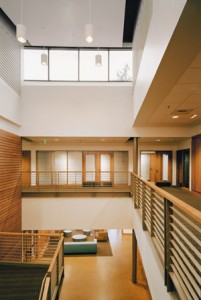 A 40,000 SF addition to Boley Library provides space for staff and faculty offices, workspace for the three law review programs, two large seminar rooms, a dramatic 2-story reading room, two computer labs, a rare book room, and two 60-seat interactive classrooms. The reading room is equipped with digital photocells for day lighting control, window shades are lowered as the sun penetrates the expansive window walls, and lighting levels increase as the sun sets. The 60-seat classrooms are designed with high-tech audio and video systems for “distance learning” and are controlled via touchscreen panels at the front of the room. Electrical design assist and Construction Administration services were provided through CBG Consulting Engineers to Soderstrom Architects (Eric Wilcox, AIA).
A 40,000 SF addition to Boley Library provides space for staff and faculty offices, workspace for the three law review programs, two large seminar rooms, a dramatic 2-story reading room, two computer labs, a rare book room, and two 60-seat interactive classrooms. The reading room is equipped with digital photocells for day lighting control, window shades are lowered as the sun penetrates the expansive window walls, and lighting levels increase as the sun sets. The 60-seat classrooms are designed with high-tech audio and video systems for “distance learning” and are controlled via touchscreen panels at the front of the room. Electrical design assist and Construction Administration services were provided through CBG Consulting Engineers to Soderstrom Architects (Eric Wilcox, AIA).
This project was selected as one of the best examples of sustainable design in the Northwest. This was phase one of a $25 million master plan expansion for Lewis & Clark College Northwestern School of Law.
Ease-of-use and scalability were the primary objectives in developing the audio-visual system for the new stadium style auditorium classrooms for the College of Law at Lewis and Clark College. The rooms needed to meet the diverse lecture needs of today and include the ability to upgrade to a full distance learning facility in the future.
The new classrooms each contain a ceiling mounted XGA resolution LCD projector which displays onto a drop-down electric screen. Instructors can present using a dedicated room computer connected to the college’s network, while guest lecturers can present simply buy connecting to the laptop port at the podium or by displaying slides/3-D objects on the XGA document camera. Each room also has an audio-visual closet which houses an equipment rack containing a VCR, DVD player and a cassette deck. The audio system consists of two wired microphones located at the podium as well as a wireless lavaliere microphone. Speakers mounted throughout the room provide balanced sound. A video camera mounted in the back of the room was added to record lectures and will later serve as a key component when videoconferencing is added for distance learning.
All of the audio-visual equipment in the classrooms can be controlled by simply using the touchscreen panel found at the front of the room. This touchpanel system allows for the control of the projector functions, switching of the source equipment, volume control of the audio system, as well as adjustments to the screen, lighting and blinds. In the event the presenter does not wish to run the audio-visual system, control may be exercised in the adjacent control room.
All of the systems work together and have the capability to handle more inputs and multimedia sources as the requirements of the classroom evolve.
